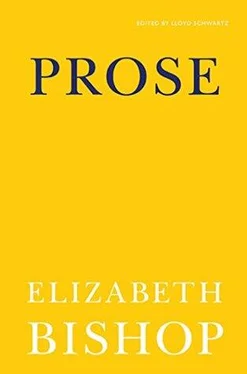Two friends of Marianne’s, two elderly Boston ladies, shared an exquisitely neat white clapboard house in northern Maine. I once spent a day there, and they teased Marianne about her habit of secreting food. She laughed, blushed, and tossed her head, and did not seem to mind when one of them told of going into Marianne’s room for a book only to discover two boiled potatoes lying on the dresser. Some years later the older lady phoned Marianne from Boston and told her she was dying of cancer. She was perfectly stoical about it, and said she was in a hospital and knew she could not last very long. She asked Marianne to come and stay near her until she died, and Marianne went. At the hospital, she told Marianne that while she would be grateful to her if she came to see her every day, she knew that Marianne couldn’t possibly spend all her time with her, so she had arranged for her to take driving lessons. Marianne, who must have been nearly seventy at the time, agreed that this was a good idea; she had always wanted to learn to drive, and she did, with a lesson at the driving school every day and a visit to the hospital. A day or so after her friend died, Marianne passed her driving test. She said she had a little trouble with the lights in Copley Square and confessed she thought the “policeman” giving her the test had been a little overlenient. I said I hoped she hadn’t driven too fast, and she replied, “A steady forty-five, Elizabeth!” On her return she proudly showed her driving license to her brother, Warner, and he, sounding no doubt very much as her mother used to sound, said, “There must be some mistake. This must be sent back immediately. ”
Marianne was intensely interested in the techniques of things — how camellias are grown; how the quartz prisms work in crystal clocks; how the pangolin can close up his ear, nose, and eye apertures and walk on the outside edges of his hands “and save the claws / for digging”; how to drive a car; how the best pitchers throw a baseball; how to make a figurehead for her nephew’s sailboat. The exact way in which anything was done, or made, or functioned, was poetry to her.
She even learned to tango. Before she acquired a television set of her own, she was in the habit of going down to the basement apartment at 26 °Cumberland Street to watch the baseball games with the janitor and his wife, who had a set. During one of the games there was a commercial that advertised a Brooklyn dancing school. Any viewer who telephoned in was guaranteed a private tango lesson at a Brooklyn academy. Marianne announced that she had always liked the tango, and hurried to the fourth floor to put in her call, and got an appointment. The young dancers, male and female, may have been a little surprised, but soon they were competing with each other to dance with her. She was given a whole short course of lessons. I asked about the tango itself, and she allowed that they had felt perhaps it was a little too strenuous and had taught her a “modified” version of it. She had also learned several other steps and dances in more current use, and insisted everyone had enjoyed himself and herself thoroughly.
In the late winter or early spring of 1963, when I was in New York, one evening around eight I emerged from a Lexington Avenue subway station on my way to a poetry reading at the YMHA. Suddenly I realized that Marianne was walking ahead of me over half a block away, alone, hurrying along with a bag of books and papers. She reached the YMHA before I did, but she was not present at the function I was attending; I wondered what she could be up to. Later she informed me that she was attending the YMHA Poetry Workshop, conducted that term by Louise Bogan. She said she was learning a great deal, things she had never known before; Miss Bogan was another of the people she considered “erudite.” Shortly afterwards I met Miss Bogan at a party and asked her about the workshop and her famous student. Poor Miss Bogan! I am sure Marianne never dreamed what suffering she was causing her. It seemed that Marianne took notes constantly, asked many questions, and entered into discussions with enthusiasm. But the other students were timid and often nonplused, and so was Miss Bogan, besides feeling that she was sailing under false colors and never knowing what technical question she might be expected to answer next.
I attended very few literary events at which Marianne was present, but I did go with her to the party for Edith and Osbert Sitwell given at the Gotham Book Mart. I hadn’t intended to go to this at all; in fact, I really didn’t want to, but Marianne, who was something of an Anglophile, was firm. “We must be polite to the Sitwells,” she said.
The party was given by Life magazine and was rather awful. The photographers behaved as photographers do: strewing wires under our feet, calling to each other over our heads, and generally pushing us around. It took some time to separate the poets, who were the subjects of the picture, from the non-poets, and this was done in a way that made me think of livestock being herded into cattle cars. Non-poets and some real poets felt insulted; then the photographer announced that Miss Moore’s hat was “too big.” She refused to remove it. Auden was one of the few who seemed to be enjoying himself. He got into the picture by climbing on a ladder, where he sat making loud, cheerful comments over our heads. Finally the picture was taken with a sort of semicircular swoop of the camera. Marianne consented to let a friend and me take her to dinner and afterwards back to Brooklyn in a cab. I had on a small velvet cap and Marianne said, “I wish I had worn a minimal hat, like yours.” The taxi fare to Brooklyn at that time was something over five dollars, not counting the tip. That evening my friend was paying for dinner and the cab. Between comments on the Sitwell party, Marianne exclaimed at intervals, “Mr. W——, this is highway robbery! ”
She told me about another, more elegant literary party she had been to in a “penthouse,” to celebrate the publication of a deluxe edition of a book, I think by Wallace Stevens. The chairs were upholstered in “lemon-colored velvet,” there was a Matisse drawing she didn’t altogether like, and she had taken a glass of champagne and regretted it all evening; it had made her face burn. I asked for further details. She became scornful: “Well, we signed our names several times, and after that thrill was over, I came home.”
Sometimes we went to movies together, to Kon-Tiki twice, I recall. I never attempted to lure her to any dramatic or “artistic” films. Since Dr. and Mrs. Sibley Watson were her dearest friends, she must have seen his early experimental films, such as Lot in Sodom. I heard the sad story of two young men, however, who when they discovered that she had never seen Eisenstein’s Potemkin insisted on taking her. There was a short before Potemkin, a Walt Disney film; this was when the Disney films still had charm and humor. After the movies they went to tea and Marianne talked at length and in detail about the ingenuity of the Disney film, and nothing more. Finally they asked her what she had thought of Potemkin. Her opinion was brief but conclusive: “Life,” she said, “is not like that.”
Twice we went together to the Saturday-morning lectures for children at the Museum of Natural History — once, to see Meshie, the three-year-old chimpanzee, who came onstage pedaling her tricycle and offered us bites of her banana. And once to see a young couple I had known in Mexico show their collection of pets, including Aguilla, the bald-headed American eagle they had trained to hunt like a falcon, who had ridden all the way to Mexico and back perched on a broomstick in their car. There were more lovable pets as well: Marianne held the kinkajou in her arms, an affectionate animal that clutched on to one tightly with his tail. In a homemade movie the couple also showed us, the young man himself was shown in his library taking a book from the shelf. As he did so, he unselfconsciously blew the dust off the top of its pages. Marianne gave one of her laughs. She loved that; it was an example of the “spontaneity” that she admired as much as she admired “gusto.”
Читать дальше












